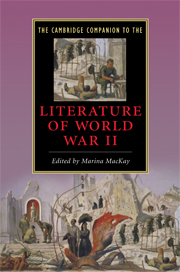13 - Life writing and the Holocaust
from Part III - Approaches and revisions
Published online by Cambridge University Press: 28 May 2009
Summary
Although the Holocaust (also known as Shoah in Hebrew and Churban in Yiddish) was an integral part of World War II, we rarely see their respective literatures shelved or catalogued together. On the one hand, distinguishing the Holocaust is historically justifiable: the intense focus on its planning and execution by the Nazis' Third Reich, the unprecedented extremes of its tortures, and the inconceivable suffering of its victims and survivors have required studying it as an event in its own right. On the other hand, this separation could be seen as mirroring the wartime neglect or even indifference to the Holocaust. The fate and rescue of the Jews and Hitler's other designated victims was not considered part of any Allied war aim. Indeed, the overarching response to reports of mass gassings and burnings was that the only way to save the victims was to win the war. Today, however, the justness of fighting the war, even in view of such misguided and horrific acts as the Allied firebombing of German cities, is predicated on acknowledging the necessity to defeat the power that would have perpetrated the Holocaust far beyond the murder of six million Jews and five million others. The particularities of its civilian experience, what we can call its homeless front, raises urgent questions about the Holocaust that relate to debates not only about comparisons to other genocides. With certainty, its literature attests to the centrality of the Holocaust to any consideration of the war and to the horrific probabilities had the Allies been defeated.
- Type
- Chapter
- Information
- The Cambridge Companion to the Literature of World War II , pp. 179 - 193Publisher: Cambridge University PressPrint publication year: 2009



